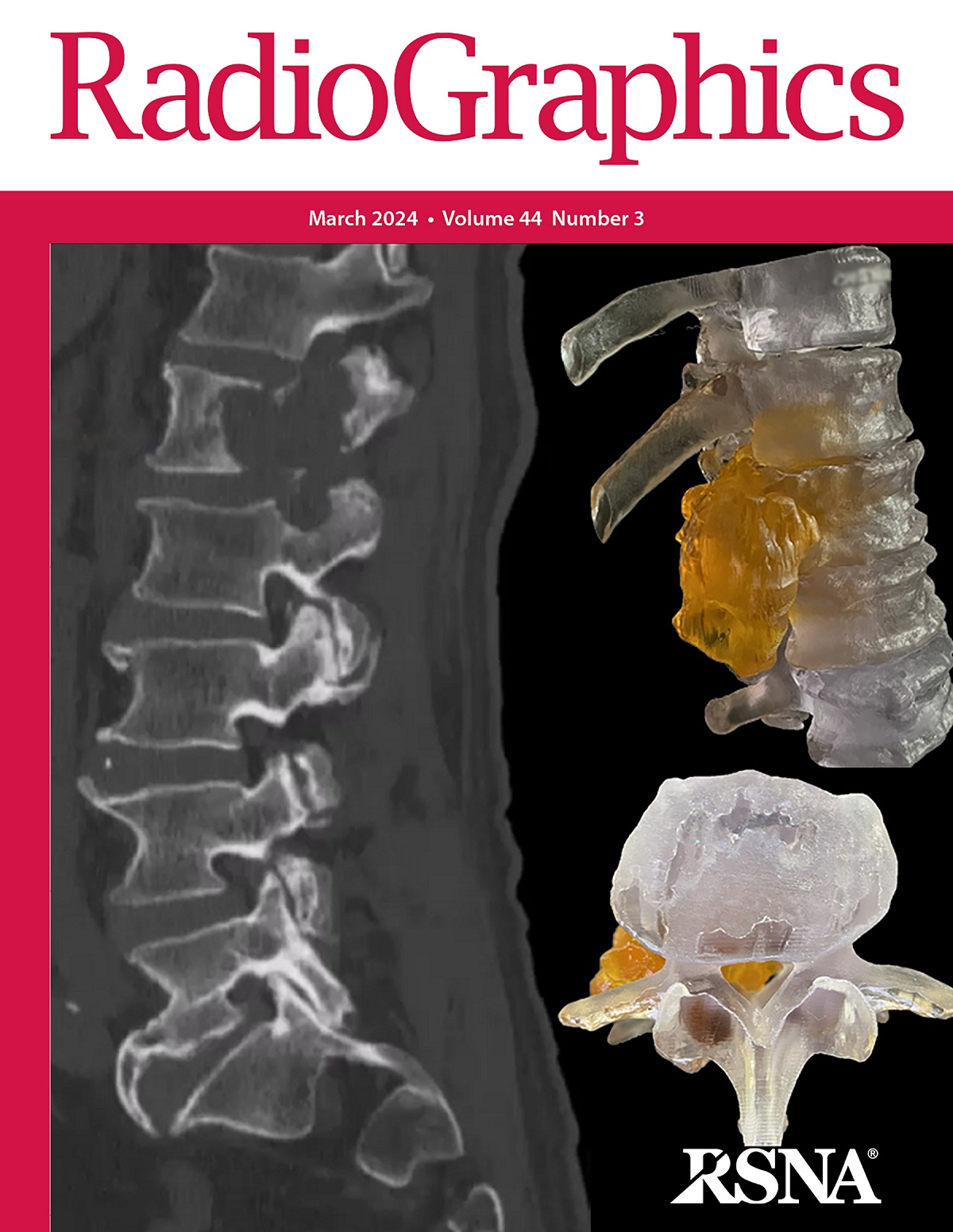Scintigraphy of Gastrointestinal Motility: Best Practices in Assessment of Gastric and Bowel Transit in Adults.
Kevin P Banks, Jonathan W Revels, Dawood Tafti, Mariam Moshiri, Neal Shah, Shamus K Moran, Sherry S Wang, Lilja B Solnes, Sara Sheikhbahaei, Saeed Elojeimy
求助PDF
{"title":"Scintigraphy of Gastrointestinal Motility: Best Practices in Assessment of Gastric and Bowel Transit in Adults.","authors":"Kevin P Banks, Jonathan W Revels, Dawood Tafti, Mariam Moshiri, Neal Shah, Shamus K Moran, Sherry S Wang, Lilja B Solnes, Sara Sheikhbahaei, Saeed Elojeimy","doi":"10.1148/rg.230127","DOIUrl":null,"url":null,"abstract":"<p><p>Various radiologic examinations and other diagnostic tools exist for evaluating gastrointestinal diseases. When symptoms of gastrointestinal disease persist and no underlying anatomic or structural abnormality is identified, the diagnosis of functional gastrointestinal disorder is frequently applied. Given its physiologic and quantitative nature, scintigraphy often plays a central role in the diagnosis and treatment of patients with suspected functional gastrointestinal disorder. Most frequently, after functional gallbladder disease is excluded, gastric emptying scintigraphy (GES) is considered the next step in evaluating patients with suspected gastric motility disorder who present with upper gastrointestinal symptoms such as dyspepsia or bloating. GES is the standard modality for detecting delayed gastric emptying (gastroparesis) and the less commonly encountered clinical entity, gastric dumping syndrome. Additionally, GES can be used to assess abnormalities of intragastric distribution, suggesting specific disorders such as impaired fundal accommodation or antral dysfunction, as well as to evaluate gastric emptying of liquid. More recently, scintigraphic examinations for evaluating small bowel and large bowel transit have been developed and validated for routine diagnostic use. These can be performed individually or as part of a comprehensive whole-gut transit evaluation. Such scintigraphic examinations are of particular importance because clinical assessment of suspected functional gastrointestinal disorder frequently fails to accurately localize the site of disease, and those patients may have motility disorders involving multiple portions of the gastrointestinal tract. The authors comprehensively review the current practice of gastrointestinal transit scintigraphy, with diseases and best imaging practices illustrated by means of case review. <sup>©</sup>RSNA, 2024 See the invited commentary by Maurer and Parkman in this issue.</p>","PeriodicalId":54512,"journal":{"name":"Radiographics","volume":"44 6","pages":"e230127"},"PeriodicalIF":5.2000,"publicationDate":"2024-06-01","publicationTypes":"Journal Article","fieldsOfStudy":null,"isOpenAccess":false,"openAccessPdf":"","citationCount":"0","resultStr":null,"platform":"Semanticscholar","paperid":null,"PeriodicalName":"Radiographics","FirstCategoryId":"3","ListUrlMain":"https://doi.org/10.1148/rg.230127","RegionNum":1,"RegionCategory":"医学","ArticlePicture":[],"TitleCN":null,"AbstractTextCN":null,"PMCID":null,"EPubDate":"","PubModel":"","JCR":"Q1","JCRName":"RADIOLOGY, NUCLEAR MEDICINE & MEDICAL IMAGING","Score":null,"Total":0}
引用次数: 0
引用
批量引用
Abstract
Various radiologic examinations and other diagnostic tools exist for evaluating gastrointestinal diseases. When symptoms of gastrointestinal disease persist and no underlying anatomic or structural abnormality is identified, the diagnosis of functional gastrointestinal disorder is frequently applied. Given its physiologic and quantitative nature, scintigraphy often plays a central role in the diagnosis and treatment of patients with suspected functional gastrointestinal disorder. Most frequently, after functional gallbladder disease is excluded, gastric emptying scintigraphy (GES) is considered the next step in evaluating patients with suspected gastric motility disorder who present with upper gastrointestinal symptoms such as dyspepsia or bloating. GES is the standard modality for detecting delayed gastric emptying (gastroparesis) and the less commonly encountered clinical entity, gastric dumping syndrome. Additionally, GES can be used to assess abnormalities of intragastric distribution, suggesting specific disorders such as impaired fundal accommodation or antral dysfunction, as well as to evaluate gastric emptying of liquid. More recently, scintigraphic examinations for evaluating small bowel and large bowel transit have been developed and validated for routine diagnostic use. These can be performed individually or as part of a comprehensive whole-gut transit evaluation. Such scintigraphic examinations are of particular importance because clinical assessment of suspected functional gastrointestinal disorder frequently fails to accurately localize the site of disease, and those patients may have motility disorders involving multiple portions of the gastrointestinal tract. The authors comprehensively review the current practice of gastrointestinal transit scintigraphy, with diseases and best imaging practices illustrated by means of case review. © RSNA, 2024 See the invited commentary by Maurer and Parkman in this issue.
胃肠道运动的闪烁成像:评估成人胃肠转运的最佳实践。
现有各种放射检查和其他诊断工具用于评估胃肠道疾病。当胃肠道疾病症状持续存在,但未发现潜在的解剖或结构异常时,常被诊断为功能性胃肠功能紊乱。鉴于其生理和定量性质,闪烁扫描通常在诊断和治疗疑似功能性胃肠病患者中发挥核心作用。大多数情况下,在排除功能性胆囊疾病后,胃排空闪烁扫描(GES)被认为是评估出现上消化道症状(如消化不良或腹胀)的疑似胃动力障碍患者的下一步。GES 是检测胃排空延迟(胃瘫)和临床较少见的胃倾倒综合征的标准方法。此外,GES 还可用于评估胃内分布异常,提示胃底容纳受损或前庭功能障碍等特定疾病,以及评估胃内液体排空。最近,用于评估小肠和大肠转运的闪烁成像检查已被开发出来并通过验证,可用于常规诊断。这些检查既可单独进行,也可作为全肠道转运综合评估的一部分。此类闪烁成像检查尤为重要,因为对疑似功能性胃肠道疾病的临床评估经常无法准确定位疾病部位,而且这些患者可能有涉及胃肠道多个部位的运动障碍。作者全面回顾了当前胃肠道转运闪烁成像的实践,并通过病例回顾说明了疾病和最佳成像实践。©RSNA,2024 请参阅本期中 Maurer 和 Parkman 的特邀评论。
本文章由计算机程序翻译,如有差异,请以英文原文为准。


